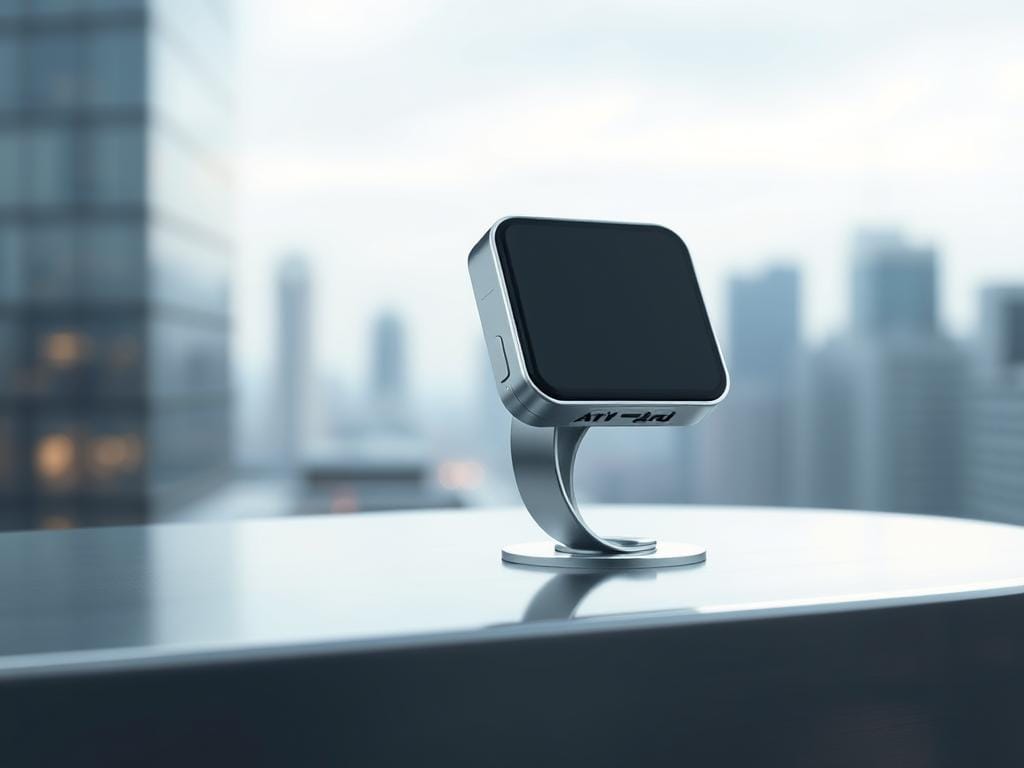Imagine a world where technology knows you better than you know yourself. The wearable AI gadgets market is expected to grow fast, reaching USD 304.8 billion by 2033. It will grow by 25.6% every year. Smart wearables are now more than just accessories. They are smart friends that change how we use technology.
AI devices have changed a lot from simple fitness trackers. Now, they are advanced digital helpers that watch over our sleep and stress. These wearables, like the Oura ring, check 20 different health signs. AI startups, like Limitless, make devices that can record and understand conversations.
These smart wearables are more than just new tech. They are our health buddies, help us work better, and connect us to a smarter future. They help us manage stress and improve our memory. Wearable AI gadgets are changing how we see technology.
Key Takeaways
- Wearable AI market projected to reach $304.8 billion by 2033
- AI wearables can improve health prediction by 23.8%
- Advanced devices now track multiple health and performance metrics
- AI-powered wearables offer personalized insights and recommendations
- Technology is shifting from tracking to proactive health management
The Evolution of Smart Wearable Technology
The journey of smart wearable tech has changed a lot. It started with simple calculator watches in the 1970s. Now, we have advanced wearables that understand and meet our needs.
Wearable tech has changed a lot. It went from basic fitness trackers to advanced wearables. These new devices give us deep insights into our health and daily lives.
From Basic Trackers to AI-Powered Devices
The change in wearable tech is amazing. Early devices just counted steps and tracked basic activities. Now, modern wearables use AI to:
- Monitor health metrics
- Predict health issues
- Give personalized advice
- Work well with other digital tools
Market Growth and Industry Projections
The wearable tech market has grown fast. Medical wearables hit $25 billion in 2020. They’re expected to reach $69.2 billion by 2028. This growth shows more people want smart health monitoring.
The $25 Billion Wearable Revolution
Devices like the Oura Ring, Garmin Instinct, and Amazfit Active 2 show wearable tech’s power. They offer features like:
- Solar charging
- Advanced biosensors
- Non-invasive health checks
- Instant data sharing
As wearable tech gets smarter, it will change how we manage our health. It will make advanced medical insights easy to get, right from our wrists or fingers.
Understanding the Impact of Wearable AI Gadget!
The world of personal tech is changing fast with augmented intelligence gadgets. These smart accessories are more than just trackers. They’re becoming our intelligent friends, understanding and predicting what we need.
Wearable AI tech is making a big difference in how we connect with digital worlds. The market for these smart companions is expected to hit $166.5 billion by 2030. It will grow by 30.4% every year from 2023 to 2030.
Key Impact Areas of AI Wearables
- Health Monitoring: Real-time vital sign tracking
- Productivity Enhancement: Personalized assistance
- Interactive Communication: Advanced gesture recognition
- Accessibility Support: Adaptive technology solutions
These smart devices are more than just accessories. They’re game-changers that fit our unique needs. From health to work, AI wearables are changing personal tech.
Market Insights
| Market Segment | Projected Growth | Key Innovation |
|---|---|---|
| Healthcare Wearables | 35% Annual Growth | Real-time Health Monitoring |
| Fitness Tracking | 28% Annual Growth | AI-Powered Personal Coaching |
| Workplace Integration | 22% Annual Growth | Hands-Free Productivity Tools |
As tech keeps getting better, these gadgets will keep making our lives easier. They’ll offer more personalized and smart experiences.
Breakthrough AI Integration in Modern Wearables
The world of wearable tech is changing fast thanks to AI. Hands-free AI assistants are making it easier to use smart devices. This opens up new ways for personal tech experiences.
AI in wearables is taking personal tech to new heights. These devices are more than just trackers. They are smart friends that get to know you and adjust to your needs.
Neural-Based Gesture Recognition
Augmented reality wearables are introducing a new way to control devices. You can use simple gestures to interact, making touch screens a thing of the past.
- Precise motion tracking
- Intuitive device control
- Seamless user interactions
Advanced Health Monitoring Systems
Wearables are changing healthcare with smart monitoring. AI sensors can:
- Detect irregular heart rhythms
- Predict health trends
- Give personalized health advice
“AI is turning wearables into personal health guardians, capable of detecting issues early.” – Tech Innovation Research
Personalized AI Algorithms
AI’s real strength is in making things personal. It uses smart algorithms to understand you. This means your device works just for you, based on your life and health.
These AI wearables are super accurate, up to 97% in health checks and predictions. They’re not just gadgets; they’re smart friends that keep learning and improving.
Smart Rings: The Future of Compact Wearables

The world of wearable tech is changing fast with smart rings. These tiny devices pack advanced features into small designs. In 2022, 17.2 million smart rings were shipped, and that number is expected to hit 50 million by 2028.
Smart rings are a big step forward in wearable tech. They can track your health in new ways. This includes:
- Heart rate variability
- Sleep quality
- Body temperature
- Blood oxygen levels
- Stress indicators
What makes these devices special is their battery life. Most smart rings last 4 to 5 days on one charge. This is longer than many smartwatches. The market is growing fast, with a 21.9% annual growth rate from 2023 to 2028.
These rings have become more than just accessories. Advanced sensors on the finger give more accurate readings than wrist devices. Some, like the Circular Ring, are even waterproof up to 30 meters.
Smart rings are not just jewelry—they’re sophisticated health and lifestyle technology that fits perfectly on your fingertip.
Prices for smart rings range from $300 to $450. As more people buy them, they’re becoming a top choice for those who love tech and care about their health.
Revolutionary Features of AI-Enabled Wearables
Intelligent personal devices are changing how we use technology. AI fitness trackers and smart ai jewelry are leading the way. They do more than just track our activities; they give us deep insights into our lives.
Today’s wearable tech is incredibly advanced. These devices can do much more than just track our fitness.
Biopotential Signal Processing
Modern wearables use complex biopotential signal processing. This lets them understand our body’s electrical signals. It’s a big leap forward for health monitoring.
- Precise health monitoring
- Real-time physiological insights
- Advanced diagnostic capabilities
Context-Aware Interactions
AI-powered wearables are getting smarter. They adapt to our surroundings and needs. They can:
- Recognize our activity patterns
- Adjust notifications based on our context
- Give us personalized advice
Cross-Device Integration Capabilities
The future of smart devices is in working together seamlessly. AI fitness trackers can now talk to other devices. This creates a unified tech experience.
“Wearable technology is no longer about tracking—it’s about understanding and improving human abilities.” – Tech Innovation Research Institute
| Feature | Capability | Impact |
|---|---|---|
| Biometric Analysis | Advanced Signal Processing | Comprehensive Health Insights |
| Context Recognition | Adaptive Interactions | Personalized User Experience |
| Ecosystem Integration | Cross-Platform Communication | Seamless Technology Interaction |
The mix of AI and wearable tech is a major breakthrough. It promises new levels of insight and interaction.
Health Monitoring Capabilities and Innovation

The world of smart wearables has changed a lot. They are no longer just simple fitness trackers. Now, they are advanced gadgets that watch over our health. These gadgets give us deep insights into our health, changing how we take care of ourselves.
Today’s wearable AI gadgets can track many health aspects:
- Continuous heart rate variability tracking
- Real-time blood oxygen level monitoring
- Advanced sleep pattern analysis
- Stress level detection
- Comprehensive activity tracking
These smart wearables use new sensor tech and AI. They turn health data into useful health tips. Even medical-grade devices can spot health problems early, helping us stay healthy.
| Health Metric | Monitoring Capability | Potential Benefits |
|---|---|---|
| Heart Rate | Continuous ECG monitoring | Early cardiovascular risk detection |
| Blood Glucose | Continuous glucose tracking | Diabetes management |
| Sleep Patterns | Comprehensive sleep cycle analysis | Improved mental health |
The wearable medical devices market is growing fast, with a 25.1% CAGR. One in three Americans use these devices to track their health. This shows a big change in how we manage our health.
Wearable technologies are not just accessories—they are powerful tools for preventive healthcare and personalized medicine.
As wearable AI gadgets get better, we’ll see even more health tracking features. This will change how we take care of our health and medical care.
Latest Advancements in Wearable AI Technology
The world of wearable tech is changing fast. AI devices are making personal technology better than ever. They bring new features that fit right into our daily lives.
Micro-Gesture Precision Control
AI wearables are changing how we interact with devices. The Mudra Link Neural Gesture-Control Wristband is a big step forward. It lets you control devices with just finger movements.
- Advanced neural recognition of subtle finger movements
- Intuitive interaction without physical touch
- Unprecedented precision in device control
Enhanced Battery Life Solutions
New battery tech is making AI devices last longer. This means you can use them for more time without needing to recharge.
| Wearable Brand | Battery Life | Price |
|---|---|---|
| Bee AI Pioneer | 7 days | $50 |
| Omi Wearable | 3 days | $89 |
AI-Driven Personal Health Insights
Wearable tech is now a big help in health monitoring. It uses AI to track your health and give you tips to stay healthy.
Wearable AI technologies are creating a new paradigm of proactive healthcare monitoring and intervention.
- Real-time biomarker analysis
- Predictive health analytics
- Personalized wellness recommendations
The Role of AI in Gesture Personalization

Augmented intelligence gadgets are changing how we use technology. They use advanced gesture personalization. AI wearable assistants can now understand our unique movements. This makes using technology more natural and tailored to each person.
AI-infused accessories have made interacting with devices better. For example, the Mudra Link wristband can detect small finger movements. This lets users control apps and devices with great precision.
- AI algorithms analyze individual gesture patterns
- Personalized interaction becomes more natural over time
- Wearable devices learn and adapt to user behaviors
New AI technologies are making gesture recognition better. Predictive algorithms now understand context and intent. This changes how we interact with smart devices.
| Technology | Gesture Recognition Capability | User Experience Impact |
|---|---|---|
| Neural-Based Recognition | Advanced movement interpretation | Highly personalized interactions |
| Context-Aware Systems | Understands complex gesture sequences | Intuitive device control |
As AI gets better, we’ll see even more advanced gesture personalization. The global AI consumer electronics market is expected to grow to $37.2 billion by 2027. This growth rate of 14.2% shows exciting times ahead for wearable technology.
Market Leaders and Innovative Products
The wearable AI market is growing fast. Big companies are changing how we use technology. North America is leading, making smart tech a part of our daily lives.
Top companies are making big strides in augmented reality wearables. Samsung, Google, and Garmin are leading the way. They’re creating AI partners that do more than ever before.
“The future of wearable technology is not just about tracking data, but understanding and anticipating user needs,” says a leading tech analyst.
Market highlights include amazing growth:
- Global market value expected to reach $200.8 billion by 2032
- Projected CAGR of 20.5% from 2024 to 2032
- Increasing consumer demand for health monitoring devices
New products are coming in many areas:
- Smartwatches with advanced biosensors
- Smart earwear with context-aware AI
- Augmented reality wearables with personalized interactions
The competition is fierce, with top companies investing heavily in research and development. The European Union’s $195 million investment in the Horizon Europe Programme shows the world’s commitment to wearable AI.
Integration with Extended Reality (XR) Platforms

Hands-free ai assistants and extended reality platforms are changing how we use technology. AI-integrated accessories are making our digital and physical worlds blend seamlessly. This was once seen as science fiction.
Google’s Android XR platform is leading this change. It’s a big step forward in wearable tech. Google, Samsung, and Qualcomm are working together to create a world where technology feels more real.
AR/VR Compatibility
New wearable gadgets work well with many platforms. A smart glasses prototype shows off its power:
- Six degrees of freedom for virtual environment navigation
- All-day battery performance
- Prescription lens options
- Real-time translation capabilities
Seamless Device Ecosystem
The Android XR platform has two main types of devices. There are immersive headsets for short use and glasses for all day. The Gemini 2.0 AI model makes these devices smart and interactive.
Future Applications
We’re expecting big changes in healthcare, education, and entertainment. AI will help us learn, talk, and explore digital worlds in new ways.
The line between physical and digital realms is blurring, powered by intelligent wearable technology.
Security and Privacy Considerations
The fast growth of ai-enhanced wearables has raised big privacy and security issues. These smart devices collect a lot of personal info, worrying users and makers.
Big privacy worries for AI fitness trackers and wearables include:
- Keeping data safe from cyber threats
- Being open about what data is collected and used
- Protecting personal health info with strong encryption
- Letting users decide what data to share
Rules like the EU’s General Data Protection Regulation (GDPR) set strict rules for smart devices. These rules require makers to:
- Use end-to-end data encryption
- Get clear consent from users
- Use strong security measures
- Keep software up to date
New security steps for ai-enhanced wearables include extra login checks and advanced face or fingerprint scans. Designing with privacy in mind from the start helps prevent data leaks.
Users need to stay alert, knowing data rights are complex. About 83% of people worry about how their info is used by wearable tech firms.
Conclusion
The world of smart ai jewelry is changing fast. Ai-driven wearable gadgets are now more than just fashion items. They are tools that help us keep an eye on our health and bring new tech ideas to life.
For example, smartwatches can spot heart problems with 97% accuracy. Smart rings can even tell us how well we sleep. These gadgets are changing how we think about health and tech.
Wearable AI gadgets are more than just a trend. They are becoming key parts of our daily health routines. They could help lower healthcare costs and give us insights tailored just for us.
Already, 41% of people are open to using AI in healthcare. This shows how these devices are set to become a big part of our lives.
We’re on the edge of a big tech change. Wearable AI devices will soon be a big part of our daily lives. As we work on issues like privacy, cost, and accuracy, these gadgets will get even better.
The future looks bright for wearable AI gadgets. They mix tech, health, and personal power in a new way. This is an exciting time for innovation that will change how we see and manage our health.
DeskBoard Buddy – The Ultimate Desk Organizer for Boosting Productivity! 🖥️✨
Tired of cluttered desks and constant distractions? The DeskBoard Buddy is here to help you stay organized, focused, and efficient. From jotting down quick notes to managing your daily tasks, this smart desk tool is perfect for streamlining your workspace!
🔥 In This Guide, You’ll Discover:
✔️ How the DeskBoard Buddy can boost your productivity
✔️ Key features that make it a must-have desk accessory
✔️ Tips to create a clutter-free, efficient workspace👉 Upgrade your workspace today!
🔗 Read the full guide here!https://devicecrest.com/blog/guides/deskboard-buddy/



1 thought on “Wearable AI Gadgets: The Next-Gen Tech Trend”